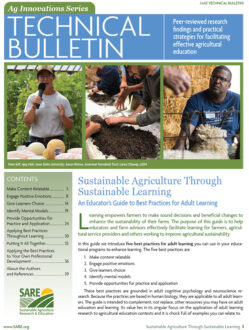Identify Learners’ Tacit Mental Models About the Content
The combination of knowledge and unconscious biases related to an aspect of an adult’s life, such as family or farming, is called a mental model. Mental models can impact how and what farmers learn. Understanding these mental models can help educators design programs that enable farmers to succeed.
The Science Behind the Practice
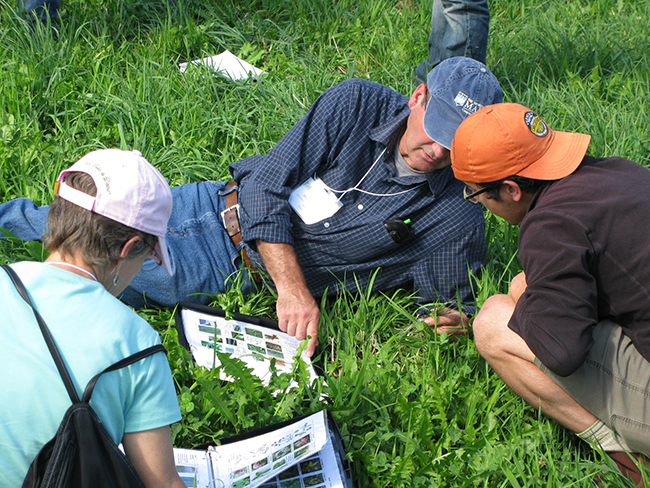
In addition to core emotions and valuing choice, the human brain has evolved other ways to ensure we survive and thrive. As described in the first best practice (make content relatable), one of these ways is the spontaneous, unconscious process of comparing and organizing things you encounter based on their similarities to things you already know or have done. This is an efficient way for the brain to manage the barrage of information it processes, and it aids in memory formation, storage and recall. The downside to this focus on efficiency is that it inevitably leads to making assumptions about new situations without taking the time to assess all their important characteristics. In social psychology, the term implicit bias is used to describe what happens when people make unconscious, automatic assumptions about other people, leading to stereotypes. Yet the brain’s tendency to “cut corners” and “put things in boxes” results in unconscious biases about practically everything in one’s life, not just how we view other people. We cannot avoid forming unconscious biases; they are an evolutionary adaptation of human brains. But we can become more aware of them and recognize that they play a role in our judgments, actions and how we perceive the world.
In large part, unconscious biases are a reflection of the types of experiences a person has had. At the same time, people gain knowledge through their experiences. This combination of unconscious biases and knowledge related to an aspect of one’s life is called a mental model. Adults develop mental models about all important aspects of their lives, such as family, work, education, recreation and government (Jones et al. 2011). Your mental model about government, for example, will be reflected in your values, preferences, expectations and assumptions about government, and conceptions of how government works or is supposed to work. Your mental model will also guide you in political decisions and actions you take.
Farmers who participate in your educational programs will have mental models that relate directly or indirectly to the content. For example, an experienced produce farmer coming to an educational program about weed management will have an existing mental model about weed management. Their mental model will be reflected in their knowledge of weed species on the farm and the problems they cause, their values about such things as chemical use, their preferences for prevention or control management strategies, their expectations about the outcome of specific interventions and their assumptions about the ease or difficulty of changing practices. The farmer’s mental model will be reflected in their past weed management practices, and it will influence how receptive they are to new information presented in the educational program.
Important Features of Mental Models
- Mental models are evident in the values, preferences, expectations and assumptions a person has regarding an aspect of their life.
- They are based on and limited by the type and extent of a person’s experiences.
- The knowledge component of a mental model can be accurate or inaccurate, depending on the limits of a person’s experience.
- Mental models are largely tacit, meaning adults are not aware of them unless they make a conscious effort.
- Mental models tend to be self-reinforcing. They guide a person to engage in activities that align with the mental model, leading them to prefer similar experiences in the future.
- Mental models can only be changed by new experiences that are significantly different from routine prior experiences.
Because adults develop mental models about key aspects of their lives, it is no surprise that farmers have mental models about farming. The past 15 years have seen a surge in research about farmers’ mental models. Findings show that mental models exert a strong influence on decisions farmers make about their operations, actions they take and how they seek out and engage in educational opportunities (Hoffman et al. 2012). Farmers’ mental models about farming often overlap with their mental models about other aspects of their lives, like family, community and health (Eckert and Bell 2005).
Agriculture educators, too, have mental models about farming, which may or may not coincide with the mental models held by the farmers they work with (Jabbour et al. 2013). Educators’ mental models are informed by their own personal and formal educational experiences, their training in scientific research, and their work with colleagues and famers in different settings. Educators’ expertise enables them to assess challenges faced by farmers and offer recommendations for changes in practice. However, if educators’ recommendations are not consistent with farmers’ mental models, farmers are not likely to implement the changes. For example, farmers who value and practice organic methods are not likely to participate in on-farm trials or use pest management strategies that are not consistent with those values (Eckert and Bell 2005).
Findings show that mental models exert a strong influence on decisions farmers make about their operations, actions they take and how they seek out and engage in educational opportunities.
In working one on one with a farmer, you can ask questions and observe practices to become more aware of the mental models that underlie the farmer’s practices and tailor your suggestions and resources accordingly. In group settings, particularly short-duration gatherings, identifying mental models of participants that relate to the content can be more of a challenge. However, there are strategies you can use to get a good appreciation for the range of knowledge, values, assumptions and preferences held by participants and can use that information to adapt the content to facilitate learning. We describe a variety of these strategies in the “How to Apply the Best Practice” section.
In some instances, farmers may base their practices on incomplete knowledge or erroneous assumptions that go untested until they experience a major setback that requires being open to new information and reconceptualizing their sense of “how things work” (Eckert and Bell 2006). Even though mental models tend to be self-reinforcing, they can change when an individual has new experiences that are significantly different from routine past experiences. Agricultural educators cannot change a farmer’s mental model, but they can support the farmer in gaining new knowledge and experiences that will enable change. The experiences of Frank, a dairy farmer in Connecticut, illustrate how this change may occur. (See the profile “A Dairy Farmer Expands His Mental Model About N Fertilization.”)
Agricultural educators cannot change a farmer’s mental model, but they can support the farmer in gaining new knowledge and experiences that will enable change.
You may be tasked with developing a new curriculum or updating an existing one. The curriculum may be targeted to a specific group of farmers, such as beginning women farmers, or to a specific topic or skill set, like supervising farm workers. As you design the curriculum, take into consideration the mental models of target participants that may impact their learning. A study by Jabbour et al. (2013) provides a good example. The authors interviewed 23 organic farmers in New England states about their knowledge, beliefs, assumptions and practices related to weed management. They uncovered two commonly held misconceptions about weeds: 1) seeds of most of the weed varieties on farms can live in the soil for 20–80 years, and 2) weeds are indicators of soil nutrients. To address these misconceptions, Extension educators modified their weed management curriculum so that they included materials that focused on weed seed longevity, and they introduced weed management in terms of soil health, rather than the science of ecological complexity.
Wrap Up
This best practice highlights the importance of identifying the mental models farmers have that may impact their learning. You can use this knowledge to tailor your programs in ways that better attend to participants’ mental models and address knowledge gaps that may underlie erroneous assumptions and misconceptions.
Next, we describe activities you can use to apply this best practice. The activities will also enable farmers to become more aware of the assumptions and biases they have related to the content. This awareness is the foundation for being receptive to trying out new ideas and skills. Because each farmer’s mental model related to the content is unique, based on their own set of knowledge and experiences, educators must ensure that the setting in which the activities occur is respectful, non-judgmental, and engages positive emotions as much as possible.
How to Apply the Best Practice
Strategies for identifying mental models related to the content.
- When working one on one with a farmer, the following open-ended questions may be especially useful in identifying for both you and the farmer aspects of their mental models that relate to their learning needs:
- What problem have you had with ___________________? How did you go about addressing it?
- Can you tell me what led you to decide ____________________? What type of things did you consider when you made that decision?
- You seem to feel strongly about ___________________. Can you tell me a bit more about why you feel so strongly?
- What do you find most rewarding about ______________? Why is this so rewarding?
- What do you find most challenging about _____________? Why does this seem so challenging?
- What do you see as the greatest obstacle for making changes in ______________? Why does this seem like a big obstacle?
- What is the key factor for your success with ____________? Can you tell me more about this factor?
- What is one thing that might make this new practice, ___________, work for you?
- Before or near the beginning of an educational program, conduct a survey of participants to ask about their specific interests and expectations for the program. For example, ask:
- What is one question you want to leave this program with answers to?
- What is your primary motivation for enrolling in this program?
- What do you hope to be able to do by the time you leave?
- What is one thing you know or have heard about ____________?
- A survey of participants is most efficiently done before a program or event via an online survey. This way you can review the responses to inform your preparation of materials and prepare a summary to share with participants at the event. When you share the summary of responses, ask participants to react. Find out if they are surprised by anything. Point out how you will address expectations or viewpoints expressed in the survey.
- If it is not possible to contact participants before an event, you can present the questions on a slide. Have index cards or paper on seats upon arrival and ask participants to respond to the prompts you provide. You can then proceed in a few different ways, depending on the nature of the event:
- Collect cards or papers with responses and review during a break. Use the responses to guide your facilitation during the rest of the event.
- If the content is likely to challenge participants’ assumptions or values, have learners keep the cards and revisit their answers at the end to see how their responses may have changed. This can be done individually, in pairs or in small groups. Use their reflections as the basis for review and wrap up, highlighting any changes in assumptions and/or values.
- When there are many participants or when time is limited, ask for volunteers to share responses. Summarize responses on one flip chart sheet and review. Highlight responses that set the stage for the content.
- With a small number of participants or when time is not limited, have participants form groups and summarize their responses on a sheet of flip chart paper. Sheets can be put up on walls for all to review, or, if time permits, each group can summarize their responses. Follow either method with a brief discussion in which you highlight responses that set the stage for the content.
- To help farmers uncover their own mental models as well as learn more about the mental models of others, ask farmers in groups of two or three to share one or more things they know or believe to be true about a topic or practice.
- Activities that may provide insight into participants’ mental models of farming include “quality of life” statements, which farmers are coached to write in Holistic Management whole-farm planning, and “mission statements,” which beginning farmers often write as part of beginning farmer education.
Review Questions and Reflections
- In your own words, how do individuals develop mental models about aspects of their lives? From a brain science perspective, what purpose do mental models serve?
- Reflect on an occasion in which you worked with a farmer who seemed to base decisions on assumptions you knew to be false. How did you handle it? What was the outcome? Using what you now know about mental models, describe one or two additional ways you could have handled it.
- List three assumptions you have about sustainable agriculture. Do these assumptions influence your teaching? If yes, how?
- Reflect on what you have learned so far from this guide about adult learning best practices. Has anything you’ve learned challenged your mental model of how to be an effective educator?
- Think of a future learning event or program you are planning. What could you do before the event or at the beginning of the event to gain an appreciation of the mental models participants have related to the content?
Profiles
A Dairy Farmer Expands His Mental Model About N Fertilization
Tom Morris, University of Connecticut Extension
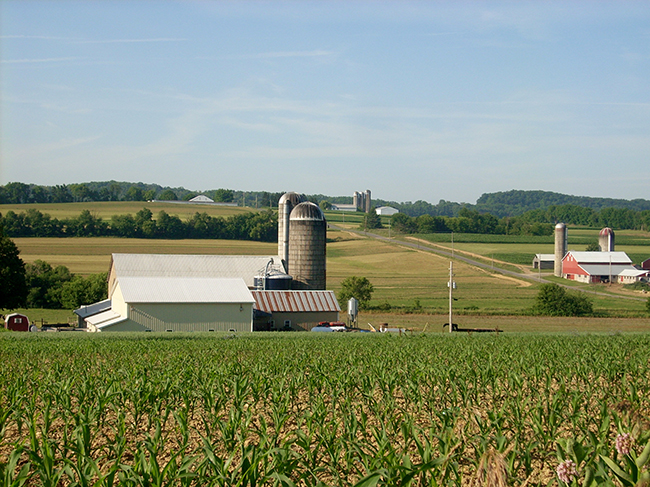
Tom Morris has worked with quite a few dairy farmers who believed that corn yield was proportional to nitrogen fertilizer rates. It took negative experiences like years with low yields despite higher rates of nitrogen application, combined with mounting societal pressure to reduce nitrate pollution of water bodies, before farmers were open to adopting new practices.
This quote from a discussion Morris had with Frank, a dairy farmer, illustrates a mental model of fertilizer application based on the erroneous assumption that more is better:
“The year before when we had so much rain, I was very concerned about losing yield from nitrogen loss in the field, and I want, you know, to get maximum yield. I don’t believe in losing yield especially if it only takes more nitrogen. This year, we didn’t have as much rain and the corn looked great. I know you said we should take some corn stalk samples to see how much nitrogen accumulated in the stalks ... and we took the samples. The stalk results were really high, and you recommended I cut back my nitrogen by 20–30 pounds per acre. But I can’t do that and risk getting a low yield. I don’t care how much nitrogen is in the stalks; I’m after maximum yield.”
The following year Frank had lower yields that he could not explain, and the corn stalk results showed excessive nitrogen at harvest. He was puzzled and sought out assistance again, asking Morris many questions about what, besides nitrogen, could be the reason for the low yields. After much discussion, Frank decided to pay more attention to weed control, planting dates and compaction, and he began to routinely use new methods, such as the corn stalk nitrate testing, which was cost-shared by NRCS. He used the test results to adjust manure and fertilizer applications for groups of fields.
Frank saw his fertilizer bill drop, and his corn yields did not suffer. His old assumptions about yield and nitrogen management foundered. Frank later joined a group that Morris was facilitating with local farmers who were in various stages of adopting these nutrient management methods for corn crops. Through sharing experiences, Frank continued to gain new knowledge of and appreciation for the variety of nuanced factors that can come into play when making decisions to maximize yields and to apply profit-maximizing fertilizer rates. In this way his mental model of fertilizer application expanded and became more complex, enabling Frank to more effectively address problems that might arise.
Gaining Insights into Farmers’ Mental Models with Props
Katie Campbell-Nelson, Northeast SARE (Cornell Cooperative Extension)
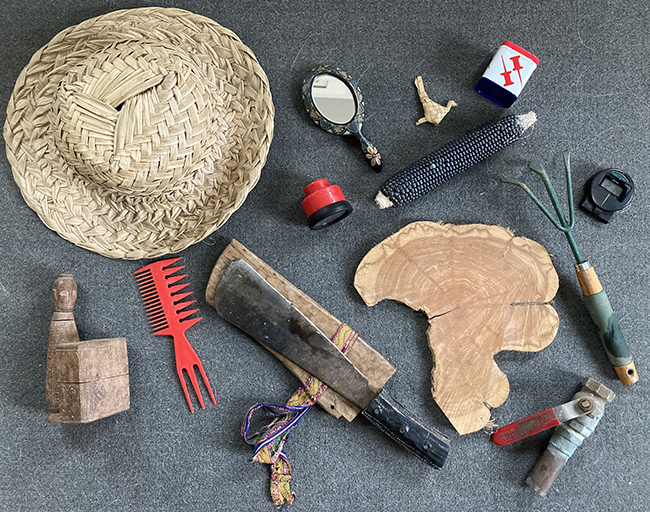
Katie Campbell-Nelson designed a creative and engaging activity that can provide insight into farmers’ mental models in any context. It may be particularly useful when you want to uncover mental models and discuss them in a positive environment, such as at the beginning of a process to understand a problem and seek solutions, or when conducting long-range planning.
The activity includes a bag of props. In Campbell-Nelson’s case, she uses random items from the home and farm such as a straw hat, a nut and bolt, a small statue or unique seed. The props have no clear connection to each other or to the topic of the event (for example, farming, soil, sustainability, managing weeds, etc.). Participants choose a prop from the bag and receive instructions to complete this prompt: The [topic or item relevant to the event] is like [this prop] because …
Participants have a few minutes to write their responses and then take turns sharing them. The connections participants make between their prop and the topic offer glimpses into the knowledge, personal views and assumptions participants have about the topic. Campbell-Nelson and her colleagues use the insights to identify barriers or misconceptions they may want to address, or viewpoints and values that can serve to motivate participants. Participants may also hear things in the responses of their peers that give them new insights and prompt them to reflect on or reconsider aspects of their own mental models about the topic. After using this exercise, Campbell-Nelson has often heard comments such as, “I’ve never really thought of it in this way before, but …”
This activity takes advantage of the brain’s natural tendency to look for connections and to make analogies between something new and what it already knows and has stored in memory. Note that this activity also covers the best practices for offering choice and triggering positive emotions of surprise and joy; it’s fun to select an interesting object from a grab bag, use it in a creative thought game and share your impressions with others in a low-risk setting.
Factors Underlying Blueberry Varietal Preferences
Heather Faubert, University of Rhode Island Cooperative Extension
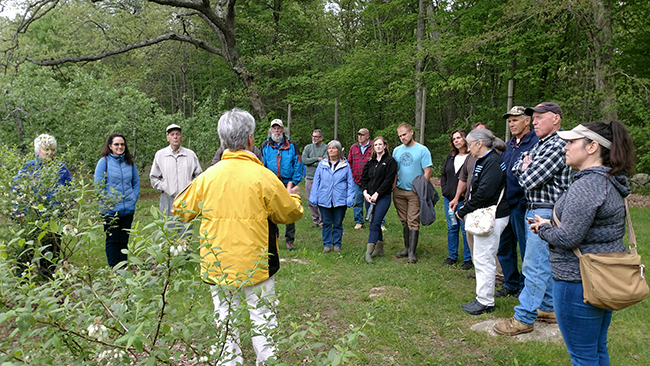
Sometimes, you can learn a lot about farmers’ mental models by exploring seemingly straightforward details about their farms. When Heather Faubert organized a session about blueberries at the large New England Fruit and Vegetable Conference, she set out to learn why farmers selected certain blueberry varieties over others.
Before the conference, Faubert interviewed 15 growers and asked them about the blueberry varieties they were growing. What was their preferred variety, and why was it preferred? What variety were they least satisfied with, and why were they dissatisfied?
Then, at the beginning of the conference session, Faubert presented the results from the pre-conference interviews and opened up the conversation to the 120 session participants. Many of the farmers enthusiastically contributed their experiences and preferences about blueberry varieties and the reasons for them.
Information shared about preferences for or against varieties provided direct insight into factors that were important in the farmers’ mental models about successful blueberry production. The summarized discussion notes, which Faubert posted in the presentation section of the conference website, provided a source of new learning for farmers who may want to reconsider their choices and for Extension educators who advise farmers on selecting blueberry varieties. Based on feedback from some participants, Faubert recognized that she could make future conversations more meaningful for farmers and uncover greater complexity in their mental models by framing the discussion using different production contexts including climate zones, soil types and cultural practices.
